Another Archaeological Find Takes Us Back to Roman Rule Over Istria
October the 3rd, 2022 - There are frequent archaeological finds all over Croatia, with most of them involving the Roman Empire being discovered in Dalmatia. One such find is yet another in a series of impressive relics which transport us back to the time of Roman rule over Istria.
As Morski writes, an impressive archaeological find was discovered down on the seabed of Barbariga bay in Istria recently. A large Roman pier, almost 60 metres long, where two thousand years ago some of the best olive oils of the Roman Empire was loaded up has been unearthed.
The sea always hides many stories both on the surface and below it, and this one in particular is a story that takes us straight back to the time when Istria was ruled by the ancient Romans.
Ida Koncani Uhac, head of the underwater archeology collection from the Archaeological Museum of Istria, said that they are investigating a Roman jetty in Barbariga bay, and at a depth of a mere three metres, archaeologists found a monumental structure - the aforementioned almost 60-metre-long Roman pier constructed with three rows of stone blocks.
''We as divers are here to help the archaeologists in their work and to take care of the safety of diving because diving needs to be done in pairs. This is the rule in diving,'' said Sandra Kamerla Buljic, a local diving instructor. This particular dive takes us back two thousand years, to the times of the mighty Roman Empire, and when the sea level was a full two metres lower than it is today
''Back during that time, one of the largest oil mills in the entire Roman Empire was located on the coast, and there were also impressive villas and a large jetty as part of the commercial port. There were no roads, and maritime traffic dominated. These ships would dock and load up the olive oil, which Pliny the Elder wrote was the second best in quality in the entire Empire, and it was then transported in amphorae.
These amphorae were produced in Fazana, also in Istria, and they were then transported to the pier. This is where oil was stored and then shipped on, mainly to the Northern Adriatic, to Aquileia, the river port of Aquileia and further inland to supply the Roman army that guarded the borders of Histria,'' explained Koncani Uhac.
Discovering a story that was forgotten for thousands of years is the job of archaeologists, and Dolores Matika, an archaeologist, stated that they are interested in whether any seeds and fruits have been preserved. More will be known after they conduct further research into these findings, but given the fact that they have found olive pits, they expect satisfactory results in this regard.
Remains of amphorae, dishes, glass and ceramics have already been found, and Koncani Uhac has claimed that they also found an interesting bowl that they managed to date to the period 15-25 years after Christ.
The research is being carried out as part of the "Istrian Undersea" project, in which as many as seventeen diving clubs are participating. All of them are exploring their areas in search of archaeological traces, and ancient remains of Roman ports have been found throughout Istria, as HRT reported.
For more, make sure to check out our dedicated lifestyle section.
Zadar Archaeologists Discover 17,000 Year Old Horse Head
September the 27th, 2022 - Croatia, much like the rest of Europe, is brimming with history from times long since gone by, and every few weeks it seems there is a brand new, very impressive find buried literally under the ground and proverbially by the ages. Zadar archaeologists have now discovered a horse head that is likely to be around 17,000 years old.
As Morski writes, traces of ancient times buried under the soil are frequently stumbled upon in Dalmatia, and Zadar aechaeologists are now on the threshold of an apparently very interesting discovery.
On the official Facebook page of the EpiC project - the Epigravetian Communities of Northern Dalmatia, they published more about their interesting find:
''Maybe it's a rainy Sunday, but even that can't stop the team. Although it seemed that we would stay warm and dry and deal with the administrative part of archaeology, curiosity came calling. At the end of the working day a unicorn appeared! We are waiting for our colleague Radovic to confirm the finding... Joking aside, we are talking about a horse that is probably around 17,000 years old! We are eagerly awaiting your suggestions for a name to give to it,'' the Zadar archaeologists said on Facebook.
''We found a horse-like head and now we are waiting for the confirmation from our other fellow scientists whether it is a species of horse that died out a long time ago or it is the remains of a wild horse. In addition, we also found traces of a hearth and the remains of hunting equipment, which is common for that era,'' research leader Dario Vujevic from the Department of Archeology of the University of Zadar told Radio Zadar.
As it was covered by a layer of earth that dates back to a period even older than 17,000 years, and coincides with the time period during which the last ice age took place, it is obvious that the animal remains also come from that period.
For more, make sure to check out our dedicated lifestyle section.
Exceptional Women in Croatian History You Should Know About
March 8th, 2022 - As we celebrate International Women’s Day, a tribute to some of the most remarkable women in Croatian history
Artists, performers, freedom fighters: Croatian history boasts many exceptional women. In a time when a woman’s role in society was mostly limited to that of a dutiful wife and mother, these fierce ladies boldly defied social norms, mastering their respective crafts, standing for their beliefs and sharing their talents with the world. This is in no way a definitive list, but only a glimpse into the many stories of inspirational women out there, starting with seven Croatian ladies you should definitely know about:
Ivana Brlić Mažuranić (1874 - 1938)
Dubbed the Croatian Hans Christian Andersen, Ivana Brlić Mažuranić rose to fame as one of the most popular Croatian writers for children.
Born to a noble family in Zagreb, Brlić-Mažuranić first tried her hand at writing educational essays and poetry. It wasn’t until 1913 that she captivated the public with a novel entitled The Marvellous Adventures and Misadventures of Hlapić the Apprentice (Croatian: Čudnovate zgode šegrta Hlapića), which quickly became one of the most loved books of children’s literature in Croatia and has retained its status to this day.
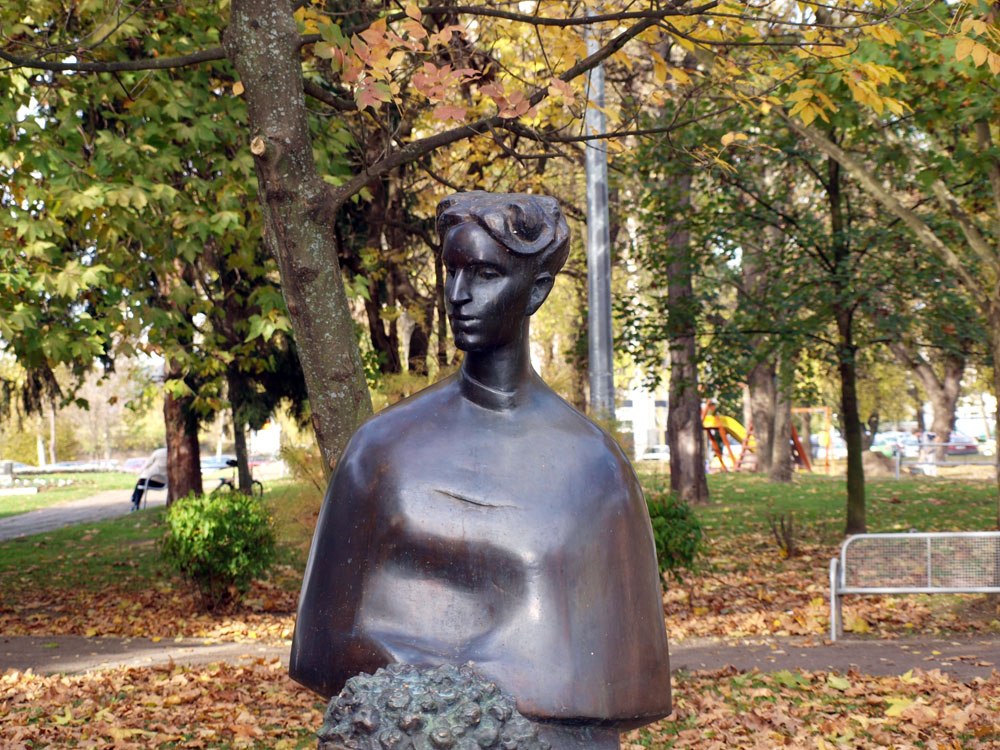 Bust of Ivana Brlić Mažuranić in Slavonski Brod / Frka, Creative Commons
Bust of Ivana Brlić Mažuranić in Slavonski Brod / Frka, Creative Commons
Her other best known work followed several years later: Croatian Tales of Long Ago (Croatian: Priče iz davnine), a collection of imaginative fairy tales rooted in Slavic mythology and folklore.
Brlić-Mažuranić was nominated for the Nobel Prize for Literature four times in a single decade, and was the first woman to be accepted into the Croatian Academy of Sciences and Arts as a corresponding member.
Slava Raškaj (1877 - 1906)
Slava Raškaj was a renowned Croatian painter, remembered as our greatest watercolorist of the late 19th century.
Deaf-mute since birth, Raškaj spent her childhood in Ozalj and was sent to a school for the deaf in Vienna at the age of eight. That’s where she first learned to draw, later going on to master the watercolour technique she'd become known for.
 Slava Raškaj, Lillies
Slava Raškaj, Lillies
Her artistic talent was recognised by a local teacher who encouraged her to seek a mentor after she returned to Croatia at the age of sixteen. Turned down by Vlaho Bukovac who was simply too busy at the time, she started training under the renowned painter Bela Čikoš Sesija in Zagreb.
Raškaj soon embraced plein air painting, capturing outdoor scenes and landscapes in her ethereal watercolours. Her work was exhibited in Zagreb, Paris, Moscow and Saint Petersburg, and ranks among the best in Croatian art.
Nada Dimić (1923 - 1942)
Nada Dimić was a national heroine who fought with the Yugoslav Partisans in WWII.
Between the ages of 16 and 18, Dimić joined the Communist Youth and the Communist Party of Yugoslavia, joined the partisans as their first notable female member, took on special assignments, worked as an undercover agent, and coordinated partisan actions in Sisak and Karlovac.
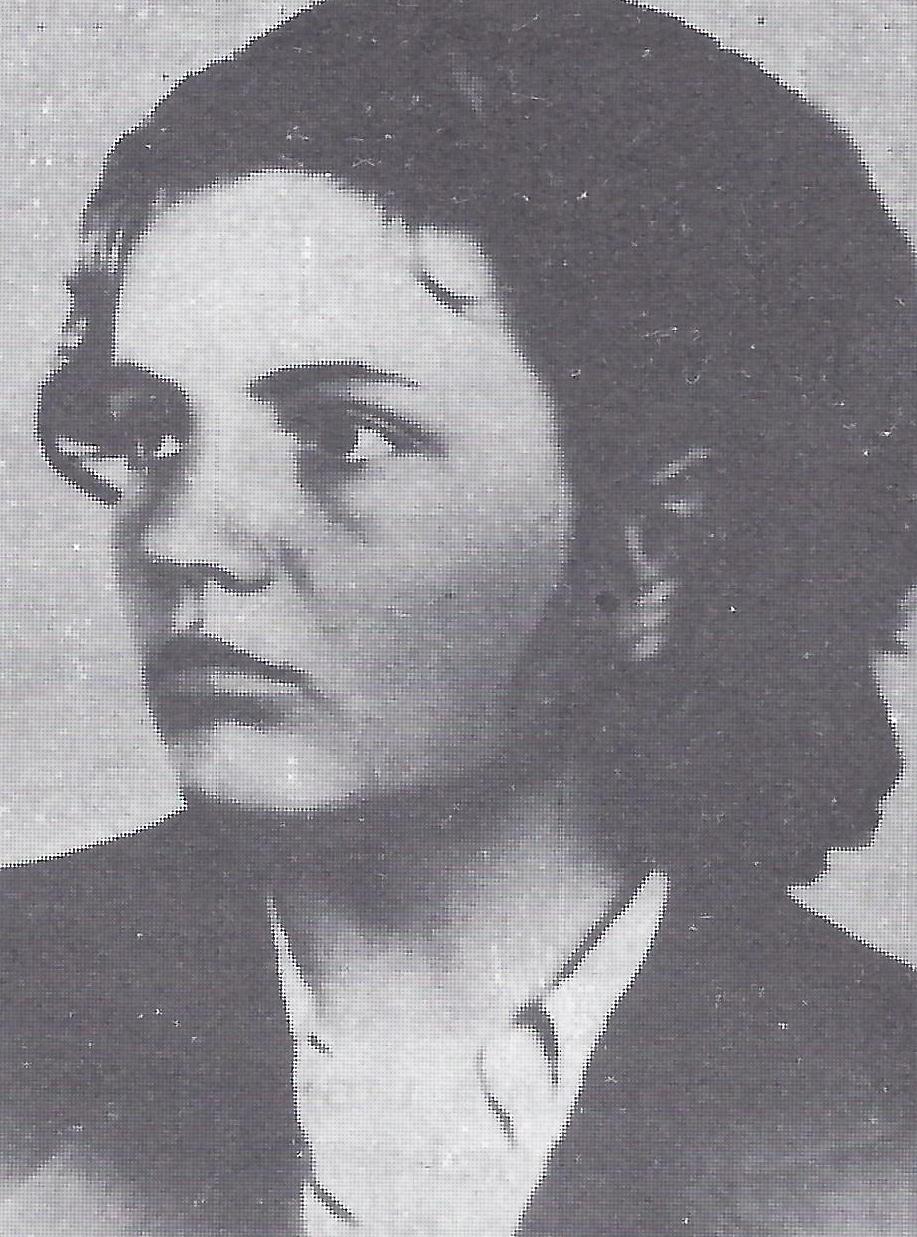
During that time, she was captured by the Ustasha and incarcerated on several occasions. In 1941, Dimić was imprisoned in Zagreb for two months, never revealing her real name despite all the torture and interrogation she was forced to endure. She was then sent to Stara Gradiška concentration camp, where she was murdered at the age of 18.
After the war, Dimić was posthumously declared a People’s Hero of Yugoslavia. Streets, schools and factories were named after the fearless heroine, including a famous textile factory in Zagreb (closed in 2000).
Dragojla Jarnević (1812 - 1875)
Dragojla Jarnević was a poet, teacher and a fierce patriot, remembered as one of the most notable members of the Croatian national revival movement.
Jarnević wrote and published impassioned patriotic poems and essays, but her most famous literary work is a personal diary she kept between 1838 and 1874. In over 1,200 pages of autobiographical notes, she also recorded her personal opinions of her contemporaries and various political events.
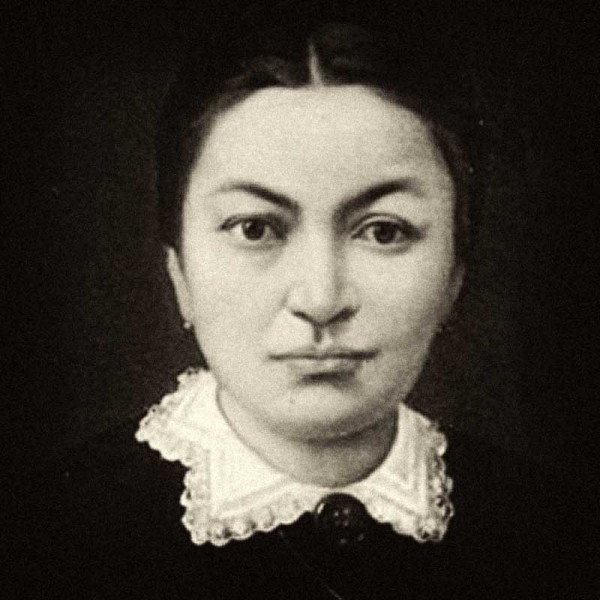
A lesser known fact about Jarnević is that she’s considered to be the first female mountaineer and rock climber in Croatia. In 1843, she famously climbed the Okić peak from the southern, steeper side of Plešivica mountain without any mountaineering gear. The trail was later named Dragojla in her honour.
Marija Jurić Zagorka (1873 - 1957)
Widely known by her pen name Zagorka, Marija Jurić was the first Croatian female journalist and one of the most read Croatian writers.
Zagorka was a patriot, feminist and activist who wrote for numerous papers and journals, including a few she herself established. As a reporter, she covered major political events in the region; she was also a relentless advocate of women’s rights and toured the region holding public lectures on the subject.
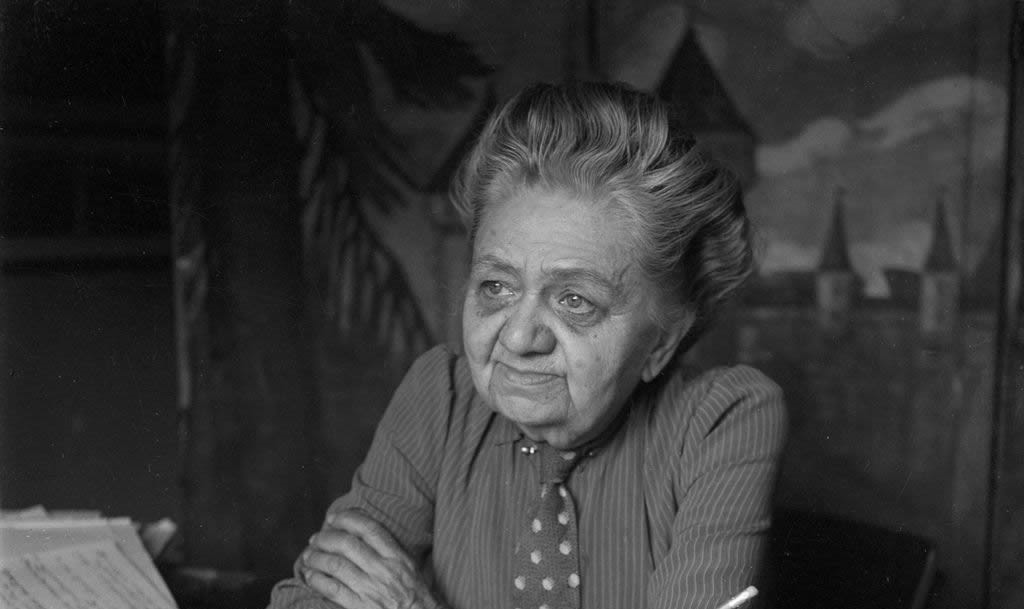
She’s an author of two dozen novels, including Gordana, the longest novel in the history of Croatian literature that counts over 9000 pages in 12 volumes. Her fiction, best described as a blend of Croatian history, adventure and romance, made her extremely popular with the readership.
Even though 11 of her novels (in Croatian) are kept at the Library of Congress in the US, none of her work has ever been translated into English.
Dora Pejačević (1885 - 1923)
Born into the famous noble family from Slavonia, countess Dora Pejačević grew to become one of the most renowned Croatian composers of all time.
As the family were known as distinguished patrons of the arts, especially music, the countess was encouraged to nurture her music talent from an early age. She first received piano lessons from her mother, and even though she went on to study music in Zagreb, Dresden and Munich, she is thought to be mostly self-taught.
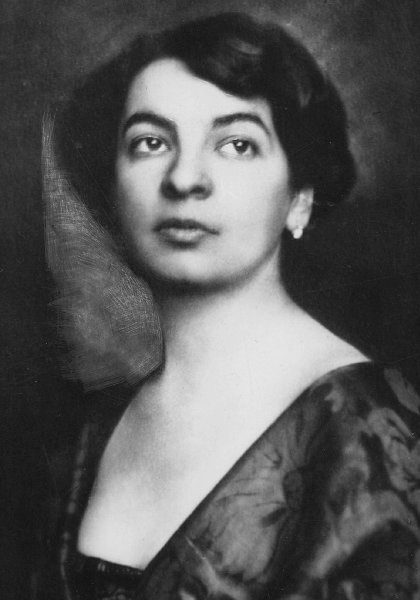
Pejačević composed the first modern symphony in Croatian music (Symphony in F-sharp minor), and is known as the author of the first Croatian piano concerto.
Mia Čorak Slavenska (1916 - 2002)
Mia Čorak Slavenska was the first Croatian dancer to ever become a prima ballerina - and arguably the greatest Croatian-born ballet dancer of all time.
Čorak trained from an early age, first taking the stage when she was five years old; at thirteen, she was already performing as a soloist. She took on the pseudonym Slavenska after she moved to Paris in the 1930s, where she soon joined the Ballet Russe de Monte Carlo.
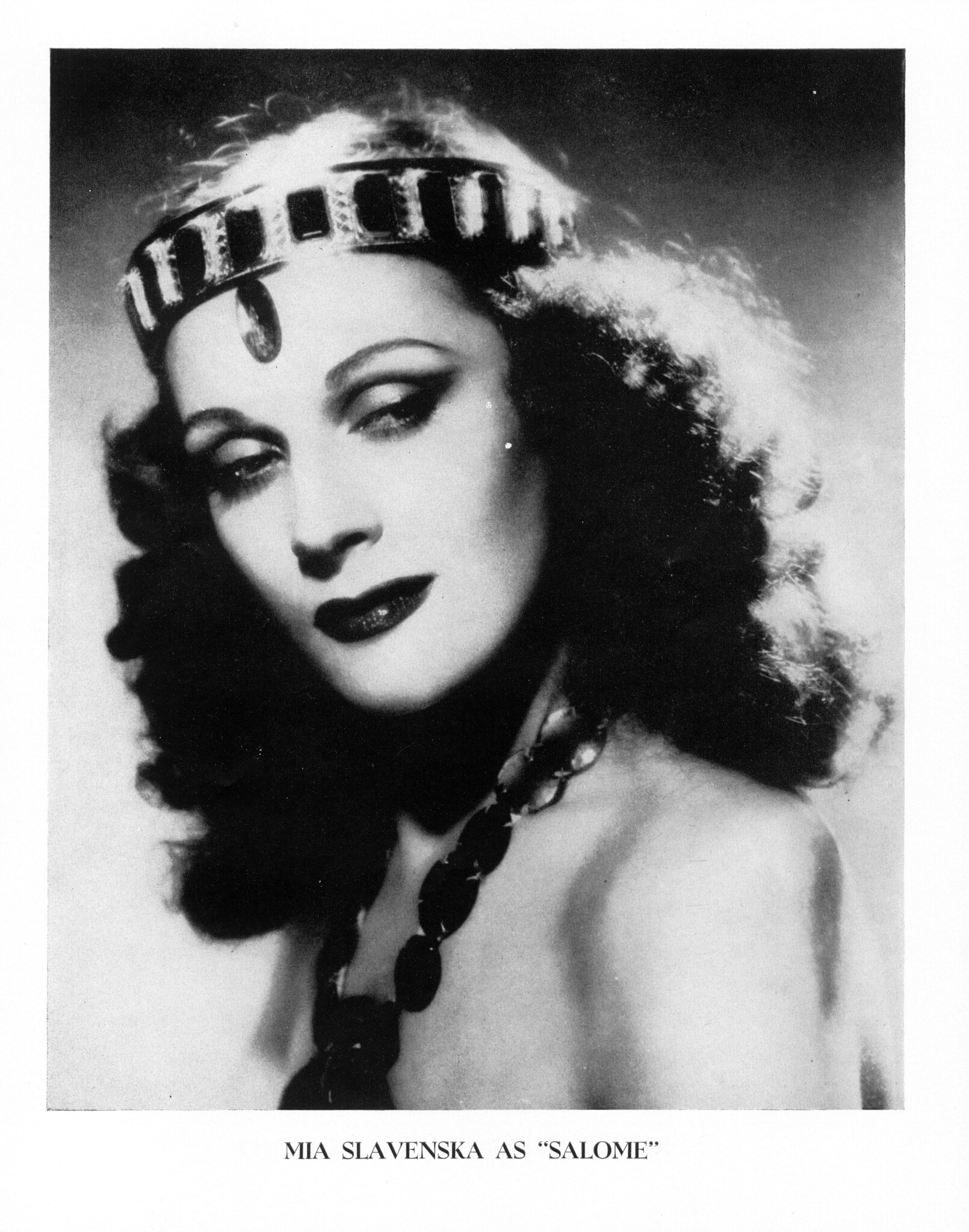 Mia Slavenska / Patrick, Flickr
Mia Slavenska / Patrick, Flickr
In the 40s, Slavenska moved to the US where she continued to dance principal roles, touring with smaller ballet troupes. After she retired as a performer, she went on to work as a reputable teacher and choreographer in New York and LA.
Milka Trnina (1863 - 1941)
Milka Trnina was a renowned opera singer who gained international fame performing in major opera houses all over Europe and the US, including the Metropolitan Opera in New York.
Trnina studied in Zagreb and Vienna, then went on to perform as a dramatic soprano in Leipzig, Graz, Bremen and Munich, over time gaining a reputation of an exceptional interpreter of Wagner and Puccini. She appeared at the Royal Opera House in Covent Garden in several roles, and debuted at the Met in 1900.
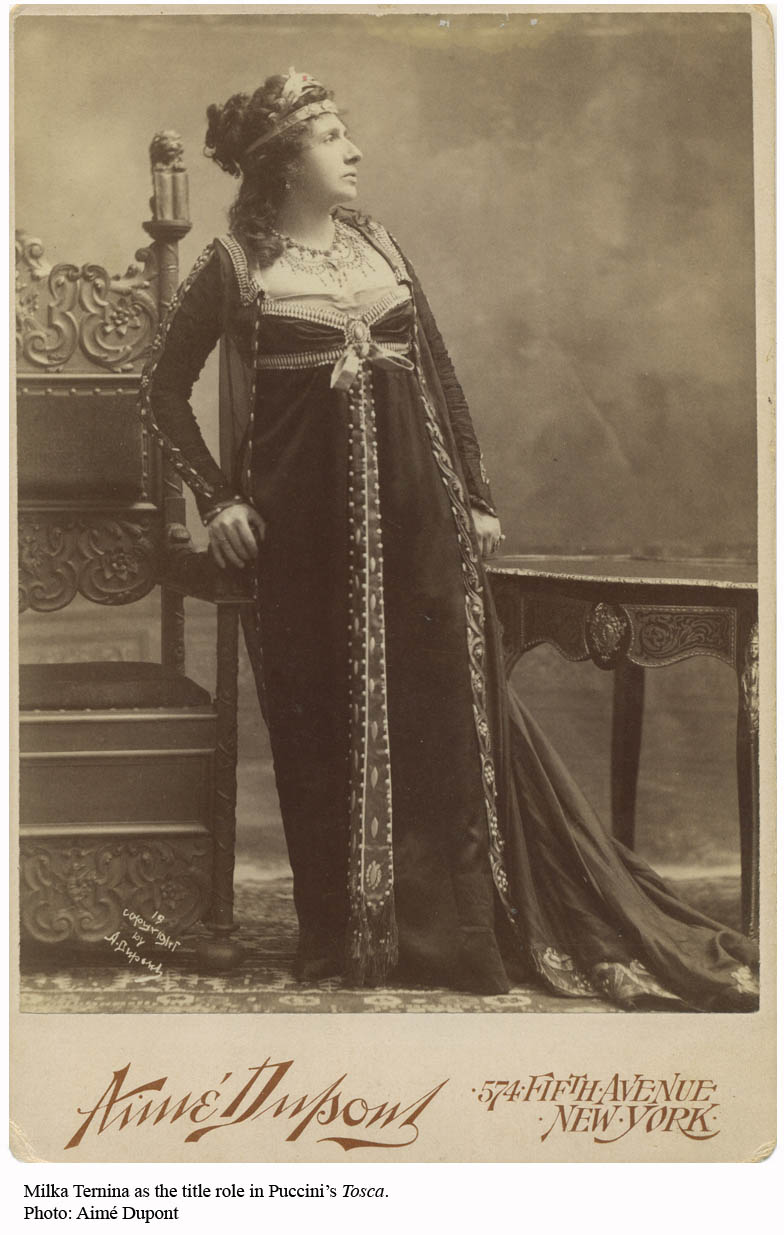
After Puccini himself attended one of her performances in London and described her interpretation of Tosca as ideal, Trnina's reputation was solidified as the most distinguished exponent of this particular title role.
Her career was cut short by an attack of facial paralysis which prevented her from maintaining her exceptional level of performance. Trnina thus retired from professional singing at the peak of her fame and moved into a teaching role, her best known pupil being Zinka Milanov who'd follow in her mentor's footsteps and also appear at the Met.
What Do X-Rays, Bullets and The Sound of Music Have in Common?
January 5th, 2022 - On this day in 1896, the discovery of X-rays first made the news. The groundbreaking invention soon had its Croatian debut, and once you start looking into the story, it quickly becomes apparent what a lively place Rijeka was at the time. Join us as we go down a historical rabbit hole, featuring a naval academy, a few visionaries - and Captain von Trapp
On January 5th, 1896 a groundbreaking scientific discovery was presented to the public. The Austrian newspaper Wiener Presse first reported that Wilhelm Röntgen discovered a new type of radiation - X rays.
While the German scientist himself named the radiation ‘X’, to this day it’s referred to as Röntgen rays in many European languages, including Croatian (getting an X-ray translates to taking a Röntgen).
A lesser known fact is that X-rays made their Croatian debut shortly after the first international reports of Röntgen’s discovery.
In the late 19th century, the Royal Naval Academy in Fiume (Rijeka) used to be one of the leading educational and scientific institutions in the Austro-Hungarian empire. Its prestigious reputation attracted a lot of talent from all over the empire, including an Austrian physicist named Peter Salcher.

Peter Salcher (1890)
Salcher joined the academy as a physics and mechanics professor, and soon became head of the meteorological station. He was a Renaissance man of sorts, a curious mind interested in science at large, as well as scientific photography and photojournalism.
It’s no wonder that the news of Röntgen’s discovery piqued his interest. On February 21st 1896, Salcher held a public lecture in Rijeka at which he demonstrated the usage of X-rays. Naturally, the local high society was eager to attend the thrilling presentation, among them baroness Josephina Mollinary-Vranyczany.
The baroness bravely volunteered as a test subject for the curious invention, and so Salcher took an X-ray of her hands before the excited audience, the first X-ray image created in Croatia. This one:
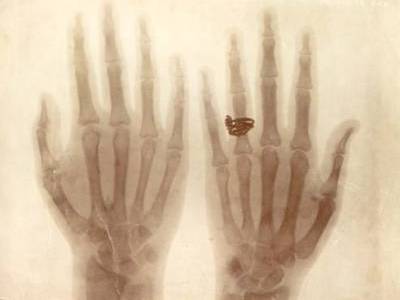
X-ray image of baroness Josephina Mollinary-Vranyczany's hands (1896)
Shortly thereafter, the city hospital in Rijeka adopted the invention and began using an X-ray device.
This is not the only thing Salcher’s remembered for, as he was the man behind another groundbreaking scientific experiment that took place in Rijeka. A decade before X-rays were invented, Salcher made history by recording the flight of a bullet shot from a firearm using a special high-speed photography technique.
He devised the experiment after he’d been approached by Ernst Mach, a physicist who was having trouble proving his shockwave theory in practice. Salcher got to work with the help of his associate Sándor Riegler, resulting in 80 shots of supersonic flying bullets. It was the first such achievement in history, and the images can be seen at the permanent exhibit at the Rijeka City Museum.
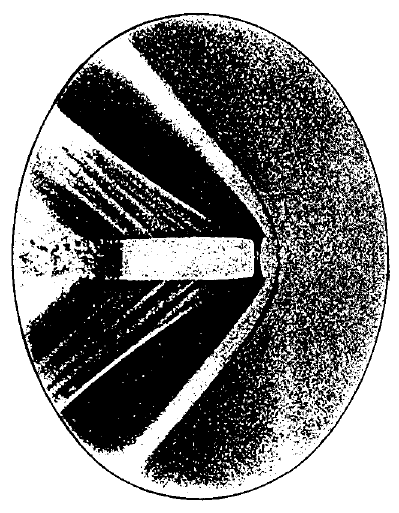
An image of a flying bullet taken by Peter Salcher (1886)
At this point, we very well might be playing six degrees of separation. Many prominent figures were part of the scientific community in Rijeka back in the day, including a particular student of professor Salcher who would later gain international fame.
It was Georg von Trapp - yes, that von Trapp, the head of the family whose story inspired The Sound of Music. A member of a noble family of Austrian origin, Georg Ludwig von Trapp was born in Zadar and entered the Naval Academy in Rijeka at the age of fourteen, which led to an illustrious military career as a naval officer.
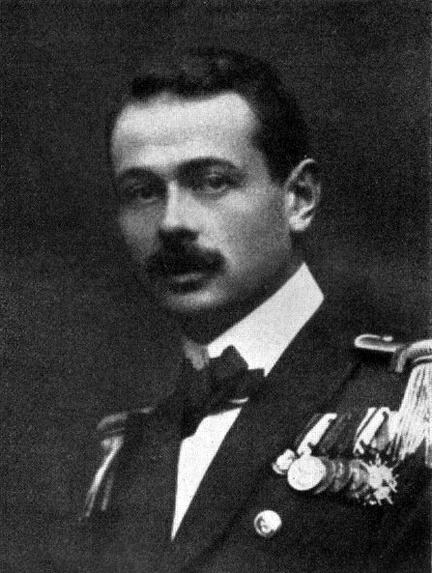
Georg Ludwig Ritter von Trapp
Von Trapp married Agathe Whitehead, granddaughter of Robert Whitehead, the inventor of the modern torpedo and founder of the world’s first torpedo factory. The couple met at the launch of a newly built U-boat in Rijeka where Agathe had the honour of christening the vessel; Georg reportedly fell head over heels for her at the celebratory ball on the same evening. They were married after a two-year courtship - learn more about their love story on the pages of the Georg & Agathe Foundation.
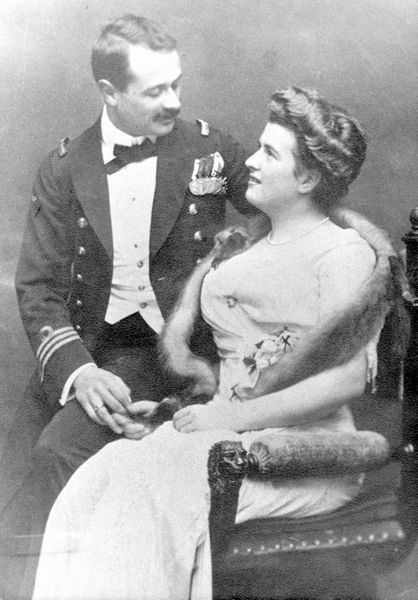
Georg von Trapp and Agathe Whitehead (circa 1909)
Agathe died of scarlet fever in 1922, and Georg moved into a villa near Salzburg with their seven children. You surely know how the rest of this story goes - he hired Maria Augusta Kutschera as the kids’ tutor, they got married a year later and had three more children together. Since everyone in the family was musically gifted, they soon started performing as a vocal ensemble around the world, eventually moving to the United States.

The Trapp Family ensemble at a 1941 performance
Maria Augusta wrote a memoir about the musical journey of the von Trapp family. It served as inspiration for several German films, the 1959 Broadway musical, and the 1965 film The Sound of Music.
So many good stories, all connected to each other - it seems Rijeka really was the place to be at the turn of the century, wasn't it?
Rags to Riches to Ruin: 200 Years of Hartera, Croatia’s Iconic Paper Factory
Did you know that the first steam engine in the Balkans was installed at a paper factory in Croatia? Or that the same manufacturing plant produced 7% of all cigarette paper in the world? It’s been 200 years since the foundation of the Rijeka Paper Mill, which grew into an industrial giant of international renown only to meet its demise in the early 2000s. A look at the legendary Hartera on November 29th, 2021
Better known by its nickname Hartera, the Rijeka Paper Mill used to be one of the focal points in the city renowned for its (former) industrial glory. Founded by a local industrialist in 1821 and further expanded by foreign investors, the factory grew into a wildly successful business over time. Hartera provided jobs to thousands of workers, its paper products were exported worldwide, and won medal after medal at international expos.
Alas, much like the majority of industry in Rijeka (and the rest of the country), the Paper Mill fell victim to the economic turmoil that followed after the war in the 90s. The factory ceased operating and the insolvency proceedings drew to a close in 2005.
This year marks the 200th anniversary of Hartera’s foundation, and the City Museum of Rijeka marked the occasion with an exhibition dedicated to the Paper Mill, its history and its workers. Named Hartera bez harte (paper mill without paper), the exhibition inspired this article as an homage to the legendary factory and its illustrious past.
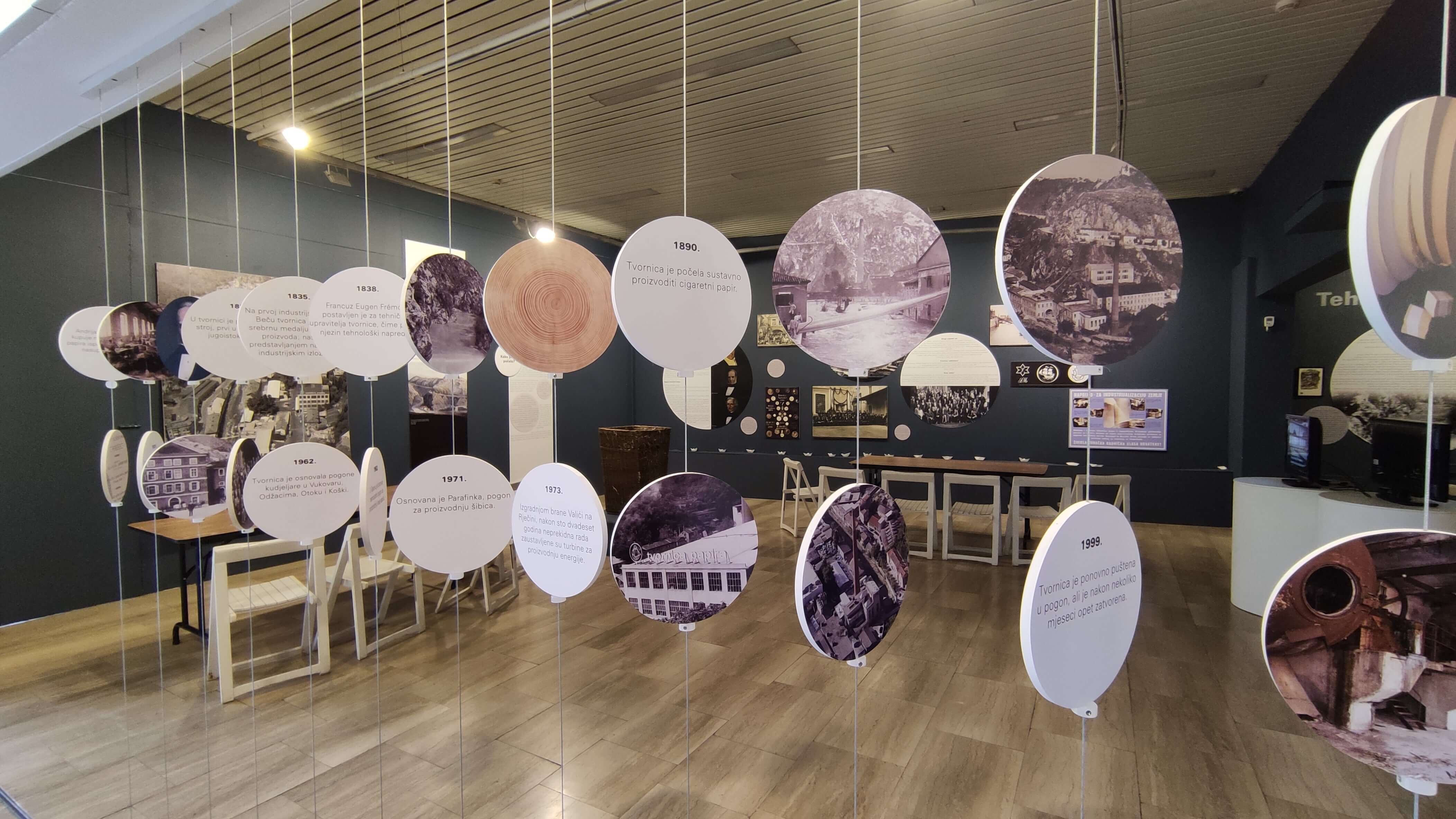
Exhibition Hartera bez harte at the City Museum of Rijeka
The story of Hartera begins with rags.
Humble rags once used to be highly coveted goods: paper was predominantly manufactured from cloth fibers until 1886 when cellulose replaced fabric as the main substance used in paper production.
Rag trade thus became quite a prolific commercial activity in these parts. Peddlers called cunjari visited small villages and went from door to door, collecting used linen and hemp cloth which they later resold to bigger buyers. Rags were in demand worldwide, and so tonnes of old cloth sourced in all parts of Croatia got exported to Trieste, London, Liverpool and New York via the harbour in Rijeka.
Andrija Ljudevit Adamich, a trader, industrialist and one of Rijeka’s best known historical figures saw an opportunity in the booming rag trade. He purchased a mill on the river Rječina in 1821, repurposing the existing facilities into a paper mill which soon employed 21 workers.
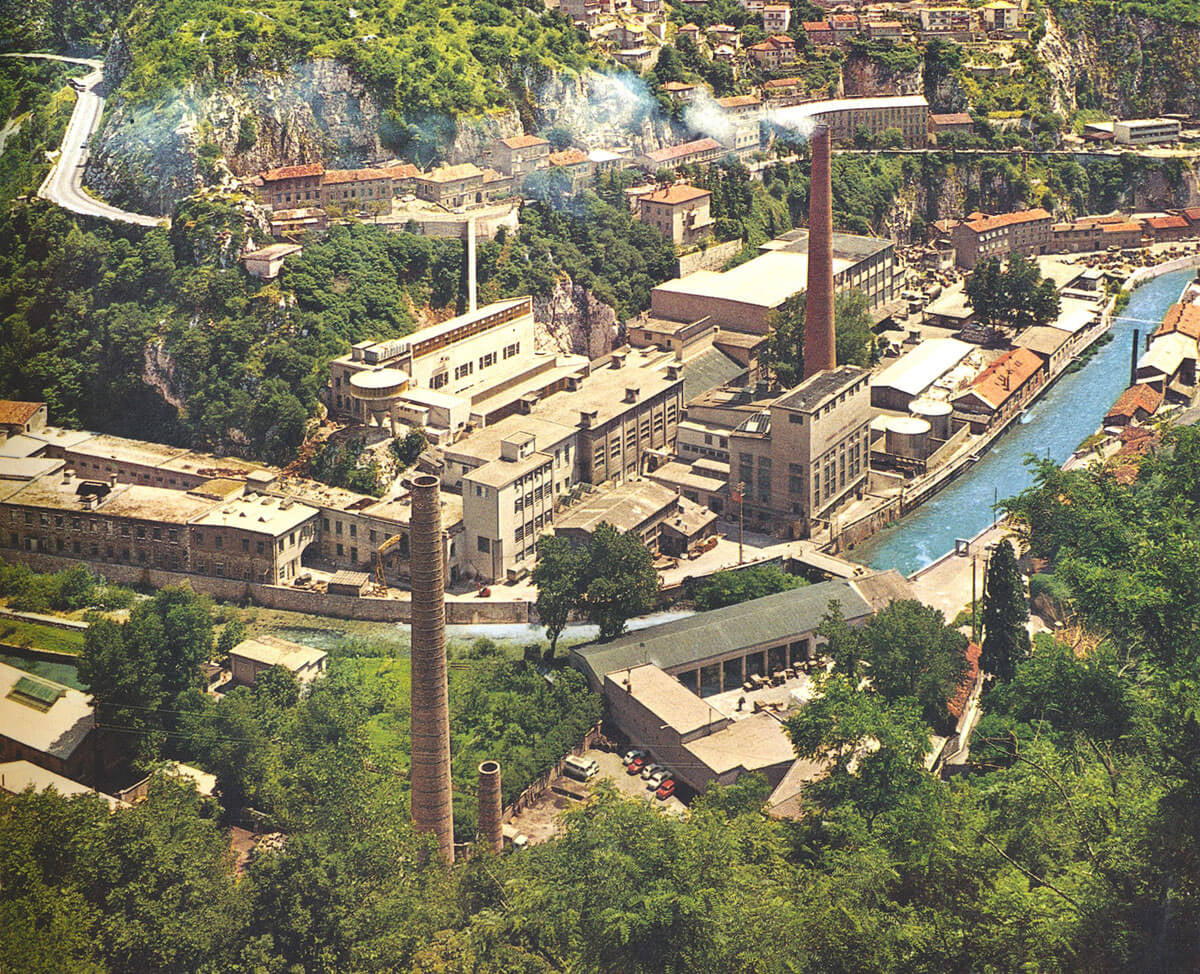
The Rijeka Paper Mill in the 20th century / Nova riječka enciklopedija - Fluminensia
The business turned out to be more of a headache than a success for Adamich. It was a time of general economic hardship, and manufacturing was made more difficult due to high production costs and procurement issues. A few years later the company was sold to foreign investors, namely Charles Meynier and Walter Crafton Smith who turned the struggling business into one of Rijeka’s industrial giants. They expanded and modernised the manufacturing plant and promptly installed a Foudrinier, the best paper making machine available at the time. Oh, and…
The first steam engine in the Balkans
Business picked up quickly after Meynier and Smith took over, and it wasn’t long until the factory employed 250 people to meet the production demand. As the output increased, manufacturing required more power, leading the owners to obtain a steam engine for the factory in 1833 - the first one in the Balkans.
It didn’t take long for Hartera paper to start amassing accolades at major industrial expos. It won a silver medal at the First industrial exhibition in Vienna in 1835, followed by awards won in Paris, Munich, London, Barcelona and Melbourne.
Interestingly enough, the company only launched its products domestically in 1878. For the first 50 or so years of operation, paper products made in Hartera were only sold on foreign markets: Italy, England, USA, Brasil, East India, and the eastern Mediterranean from Greece and Turkey to Jordan and Egypt.
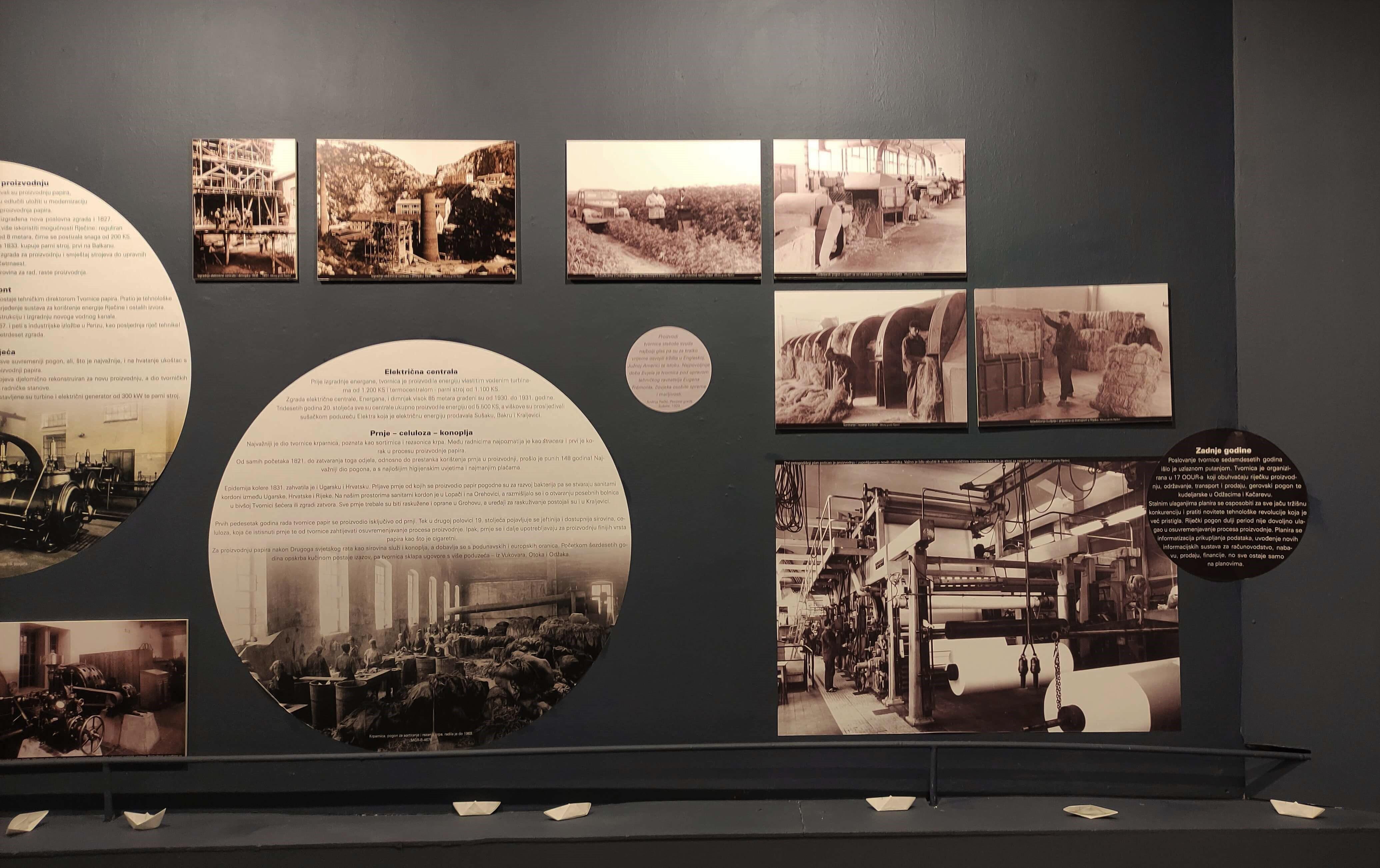
Poor working conditions
While the factory might have had the best manufacturing equipment money could buy at the time, and operated with such success that its workforce expanded significantly with each passing year, working conditions were far from ideal.
At the end of the 19th century, the company employed some 600 people; the factory operated around the clock, with everyone working 12 hour shifts with a single one hour break. No workwear or protective gear was provided to employees, leading to frequent injuries on the floor.
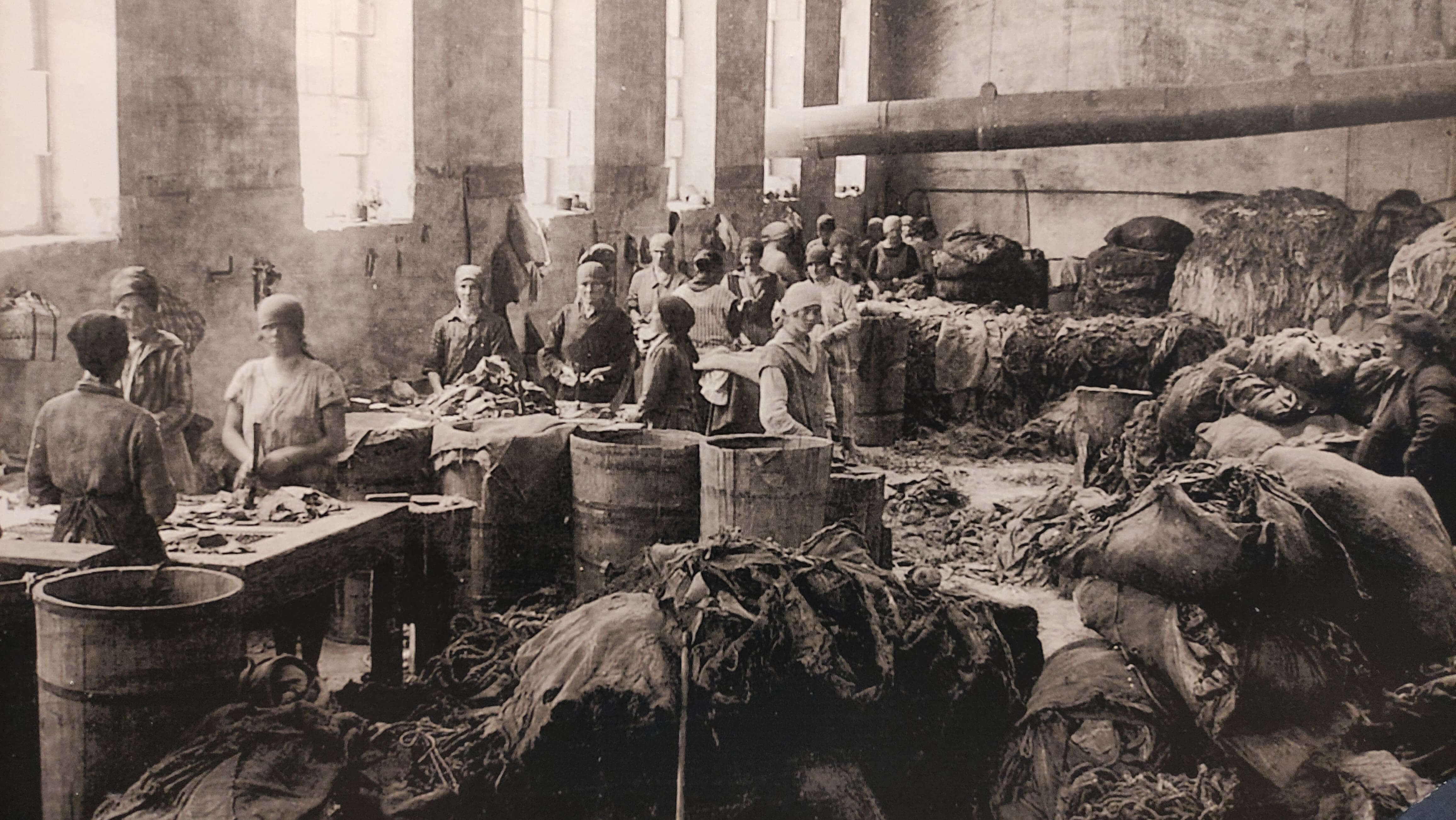
Workers at the rag sorting hall
Hygiene standards weren’t a thing either, the rag sorting facility being the worst offender in this regard. The workers had to sort through mounds of dirty used fabric riddled with bacteria (again, without any protective gear), leading to a slew of infectious diseases.
Considering that some diseases were not yet studied or had no known cure at the time, they were often referred to by alternate names. Anthrax was widely known as the woolsorter’s disease, or in Hartera’s case, cunjavica - the ragpicking disease. In the late 1880s, a particularly severe outbreak of anthrax resulted in the tragic death of 22 women workers.
On labour rights
Fed up with the poor working conditions, workers from several factories in Rijeka got together in 1906 and staged a mass strike. All 600 of Hartera’s workers joined the strike with a few demands: they called for shorter shifts, a day off on Sundays, and a 20% raise. Additionally, they asked for an employee board to be established, composed of eight workers who would serve as intermediaries between the company owners and the rest of the workforce.
The management responded by firing them all.
Things started to look up in the following few decades, though. Several syndicates negotiated with the management, leading to a collective agreement in 1938 which saw quite a few improvements to the working conditions at the paper mill. Employees were to work eight hour shifts, six days a week, and get paid every Saturday. Men earned 5 dinars per hour, whereas women got 4,5. After two years of employment, all workers earned a right to six vacation days a year. The company was also finally required to provide protective workwear and washing facilities with cold and hot water.
Why ‘Hartera’?
The Rijeka Paper Mill was officially named Tvornica papira (paper factory), but the enterprise has more often been referred to as Hartera to this day. Where does the nickname come from?
The Croatian word for paper is papir, but is called harta in the local dialect - which soon resulted in hartera, a logical name for a place where harta was made.
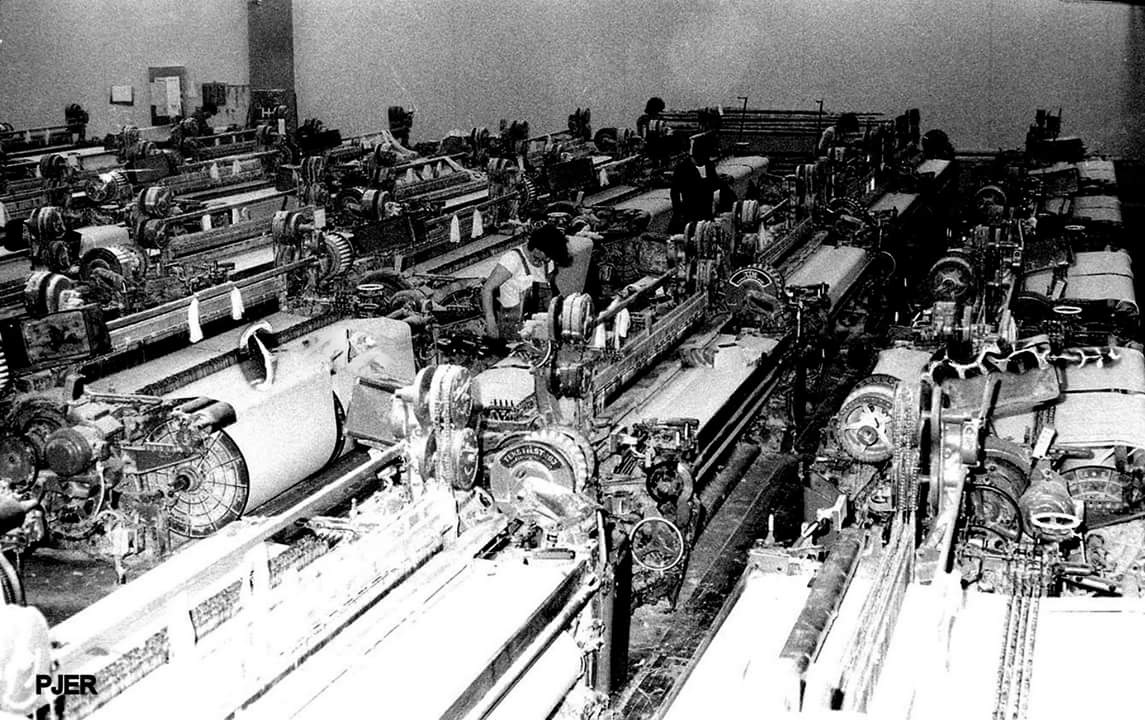
Pero Lovrović Pjer / Nova riječka enciklopedija - Fluminensia
Paper production
A wide range of products was manufactured in Hartera ever since the factory first started operating, mostly various types of writing and packaging paper.

Cigarette paper was first made at the factory towards the end of the 19th century, and over time became one of the company’s most popular products. Quality was of utmost importance, and the factory even procured a tobacco blend called harman to test the rolling paper on the particular blend it was made for.
In the 1980s, Hartera accounted for 7% of global cigarette paper production.
4 billion matches a year
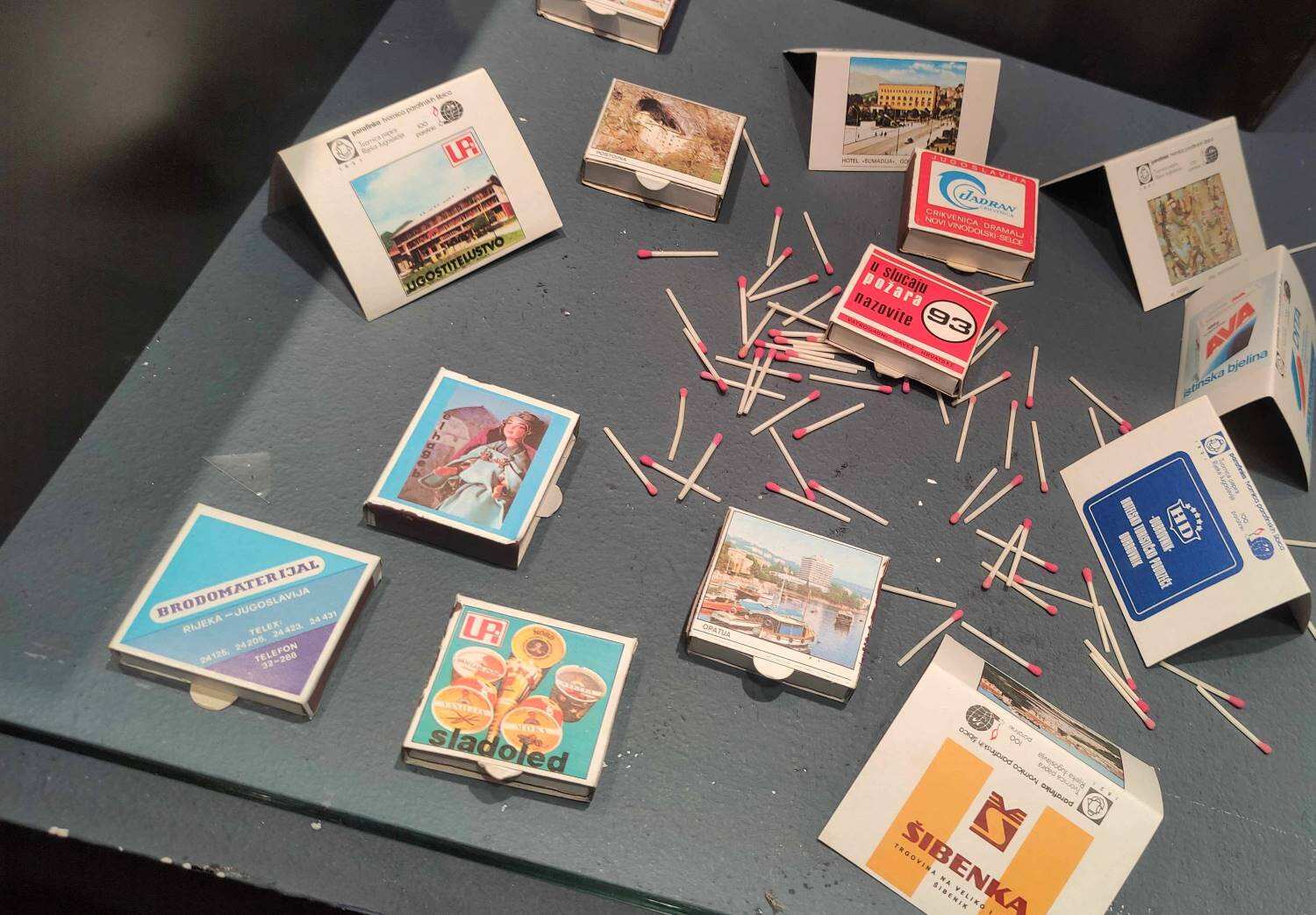
In 1971, one part of the Hartera plant was repurposed into a match factory named Parafinka. It was the only paraffin match factory in former Yugoslavia and became immensely successful within a decade: a report from 1981 shows that Parafinka produced around 48 million matchboxes that year, each box containing 80 matches. That’s close to 4 billion matches! If the figure is hard to grasp, let’s put it this way: if you were to arrange all those matches in a single line, it would circle the Earth three times.
Matches were made of Hartera’s thin, tightly rolled paper and then dipped in paraffin, resulting in a product which was thinner and shorter than wooden matches. The packaging was quite attractive, with colourful prints announcing major events and manifestations, advertising businesses, or promoting the region’s natural beauty and cultural heritage.
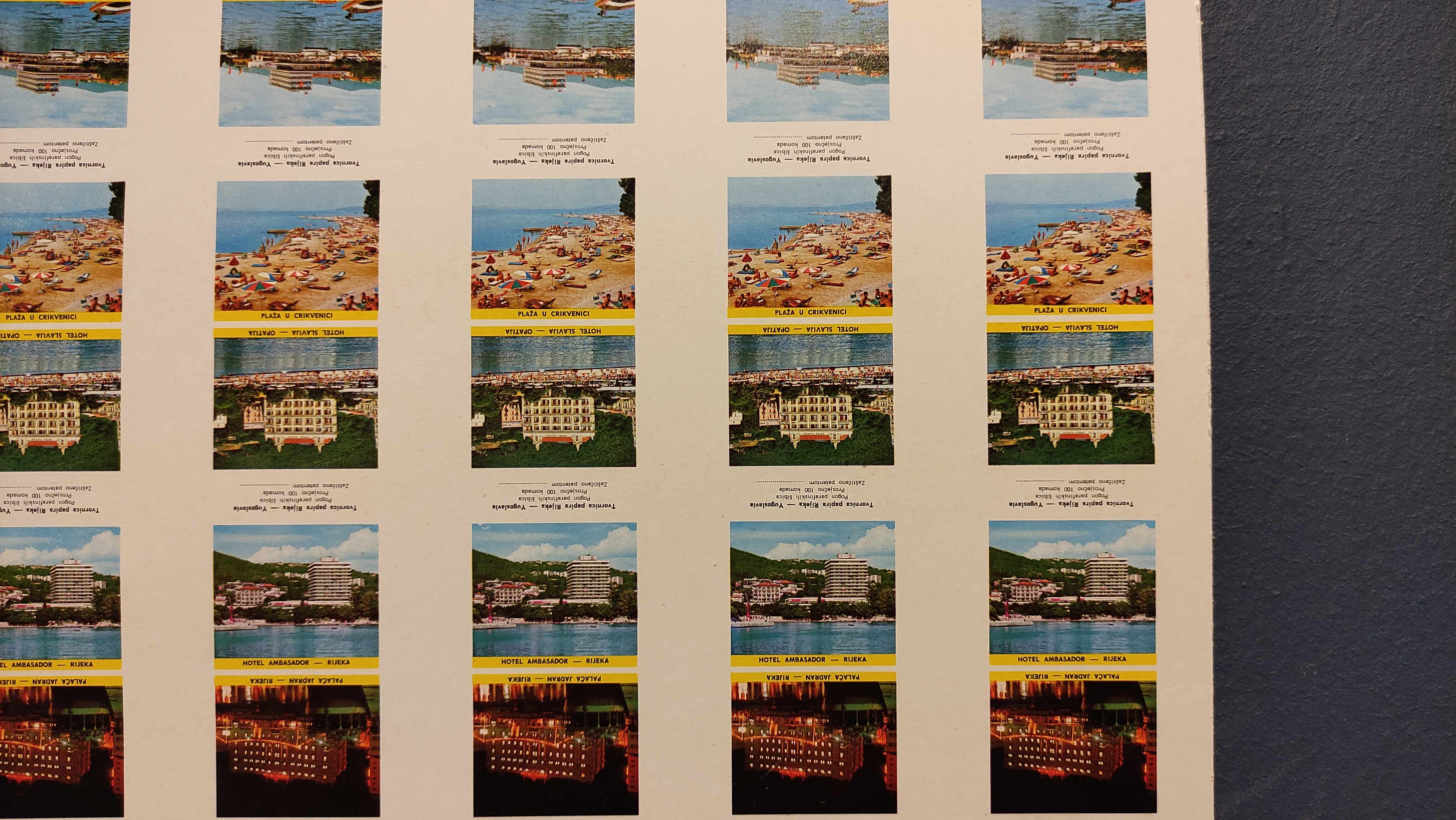
Parafinka matches were exported worldwide, including Libya, Egypt, USSR, Hong Kong, Austria, Switzerland, Belgium and the Netherlands.
Crises, disasters and the final blow
In almost two centuries of operation, the paper mill faced economic crises, wars, and a few natural disasters. The river Rječina was the main source of power for the factory, but also a destructive force. One severe flood damaged the plant in 1852, and the entire mill had to close down for several months after another disastrous flood in 1898. Flooding wasn’t the only threat: various parts of the plant burned down on four occasions at the turn of the 20th century.
Hartera survived all the hardships and - save for a few hiccups - continued to thrive until the war. In 1991, the company was at the height of its power: it employed over a thousand people and was the second biggest paper manufacturer in Europe.
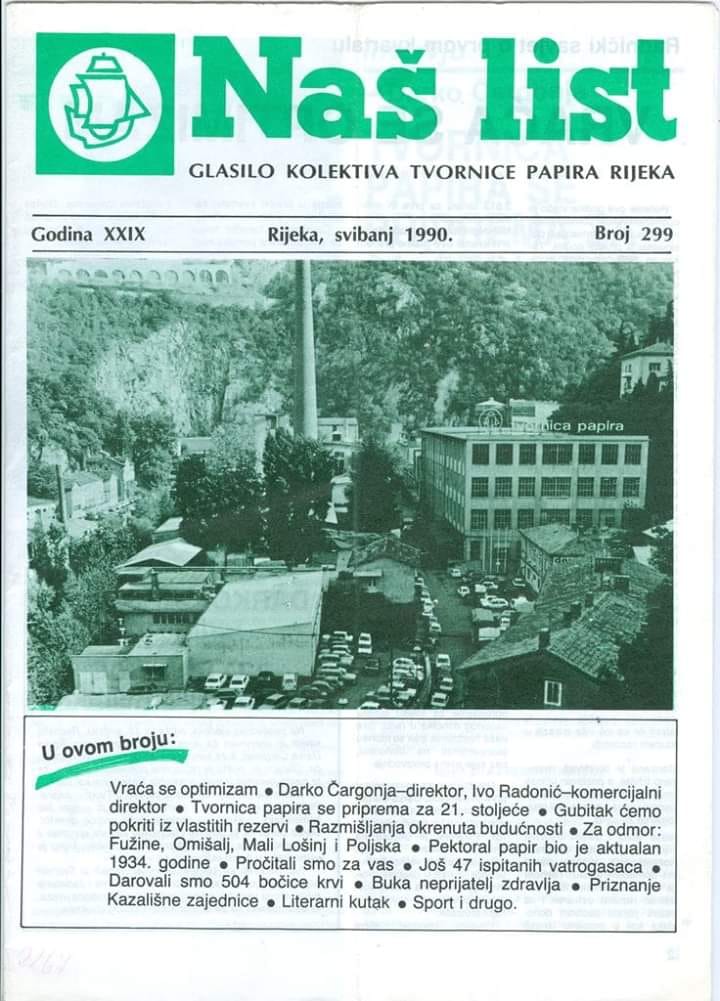
Rijeka Paper Mill bulletin from 1990 / Nova riječka enciklopedija - Fluminensia
Unfortunately, the war times and the economic turmoil that followed turned out to be the only hardship Hartera couldn’t survive. Substantial losses led to the factory closing down and the company declaring insolvency in 2005.
Uncertain future
After the paper mill ceased operating, the factory turned into a unique venue for a music festival. Named after the location, the Hartera Music Festival took place in the derelict factory halls until 2016, when the ruinous objects were declared unsafe and the festival moved to another location.
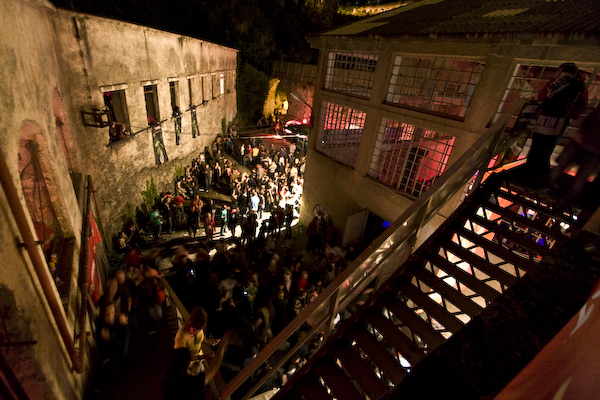
Hartera Music Festival in 2008. Source: Tim Ertl / Flickr
The Hartera festival was part of an initiative aiming to revitalize the area and preserve an important part of Rijeka’s industrial heritage. The City initially expressed interest, but the plans fell through due to lack of funding and a bureaucratic wall; the same happened a few years later after another initiative was devised to transform the Hartera complex into a socio-cultural centre which was supposed to breathe life - and business - into the largely abandoned area.
It remains to be seen if anything will come of the plans to revive the rundown factory. The outlook isn't hopeful, but one thing is certain: the Hartera paper factory and its workers are an integral piece of Rijeka's history and will always remain a part of the collective memory of its citizens.
The content of this article is largely based on the information displayed at the exhibition Hartera bez harte at the City Museum of Rijeka (author of the exhibition: Kristina Pandža). Unless noted otherwise, photos were taken by the author of the article.
Minister: It's Unseemly for President to Announce Show for Commemorations
April 24, 2021 - Transport Minister Oleg Butković said on Saturday that it was unseemly for President Zoran Milanović to announce a show for commemorations marking important Croatian historical anniversaries.
Asked by the press while he attended a campaigning event of the Croatian Democratic Union (HDZ) mayoral candidate in the City of Rijeka about Milanović's latest statements, including his claim that that the coming commemoration of the 1995 military and police operation "Flash" would turn into a show, Butković commented: "That says about him!"
"I think that it is unseemly for the head of state to announce shows at any events commemorating important events from the Croatian past," Butković said, adding that the 1995 Flash operation was important for the defense of Croatia.
Butković dismissed Milanović's claim that the recent presentation of the National Recovery and Resilience Plan (NPOO) was insufficiently transparent.
The whole Croatian public is informed that the work on the plan started in August last year. All the ministerial departments were included in the elaboration of the document, Butković explained.
He went on to say that one could not like the document, but the claims about insufficient transparency in the adoption of the plan did not stand.
For more about politics in Croatia, follow TCN's dedicated page.
Wreaths Laid for Victory Day
ZAGREB, May 8, 2020 - On the occasion of Victory Day, May 8, and the 75th anniversary of the liberation of Zagreb, delegations of the Office of the President, the Government and the Parliament, as well as a delegation of the City of Zagreb, laid wreaths at the Tomb of National Heroes at the city's Mirogoj cemetery on Friday.
On the occasion of the two anniversaries, the Alliance of Antifascist Fighters and Antifascists (SABH) issued a statement, saying that Croatia must and should celebrate Victory Day, while the Network of Antifascist Women of Zagreb (MAZ) issued a statement warning about historical revisionism.
"The Croatian antifascist movement was very important and was actually the strongest (along with the Bosnia and Herzegovina movement) part of the Yugoslav antifascist movement, and consequently it was the strongest antifascist movement in Europe, not taking into account the occupied parts of the Soviet Union. Croatia can and should celebrate that day for many reasons," SABH said.
It noted that the antifascist coalition was a short-lived alliance of very heterogeneous and antagonised states, political movements and ideologies, temporarily united in "a bitter self-defence against aggressive Nazi-fascist states and their satellites."
The Axis states equally threatened to destroy parliamentary democracy, communism and many achievements of modern civilisation, SABH added.
MAZ issued a statement warning about the activities of historical revisionists and organisations which violated the rights of women and the LGBT community and the active incitement of intolerance towards ethnic minorities.
Intolerance is being fomented "as police mistreat and illegally deport refugees," it said.
"While we await a new beginning after the crisis caused by the pandemic, with the reconstruction of the city being the most important task, we must not allow the dregs of society to continue freely implementing reactionary policies. They cannot take away our history, which is a history of resistance and struggle for a better tomorrow," says the association.
More politics news can be found in the dedicated section.
Zagreb to Host Conference on Anti-Fascism and Fascism
ZAGREB, February 17, 2020 - The SABA RH antifascist alliance in Croatia will organise an international conference on fascism and anti-fascism in the present-day Europe in Zagreb on 20 and 21 February.
Presenting the goals of the conference, the association's leader Franjo Habulin said at a news conference in Zagreb that the event would be part of the efforts to counter the strengthening of extreme right wing politics and more and more aggressive attacks on the values of the anti-fascist struggle, which, he said, were the biggest values of the present-day Europe.
Habulin said that the victory against the fascist regimes in 1945, after they had caused the Second World War, did not mean that fascism had disappeared from the historical scene.
He also pointed out that there were "more refined appearances" of fascism in a great number of European countries.
He criticised Resolution 1481 adopted by the Council of Europe in 2006 which underlined the need for international condemnation of crimes of totalitarian communist regimes as a document that equates fascism and communism. He added that that historical revisionism also originated from that document.
In the resolution 1481/2006 of the Council of Europe Parliamentary Assembly (PACE), issued on 25 January 2006 during its winter session, the Council of Europe "strongly condemns crimes of totalitarian communist regimes". The Parliamentary Assembly refers to its Resolution 1096 (1996) on measures to dismantle the heritage of the former communist totalitarian systems. The paper condemned "the massive human rights violations committed by totalitarian communist regimes". It also "calls on all communist or post-communist parties in its member states which have not yet done so to reassess the history of communism and their own past, clearly distance themselves from the crimes committed by totalitarian communist regimes and condemn them without any ambiguity."
Habulin told the news conference that the rise of neo-fascism was accompanied by the process of degrading and vilifying anti-fascist fighters from the Second World War and their contemporary followers.
The organisers of the Zagreb conference have invited representatives of anti-fascist associations from 25 European countries, including 15 EU member-states.
Some of the guests will be Vilmos Hanti, the head of the International Federation of Resistance Fighters - Association of Anti-Fascists also known by its French initials FIR, as well as Dan-Viggo Bergtun, the president of the World Veterans Federation.
More history info can be found in the Politics section.
Croatia to Showcase Its Maritime Culture in France
SPLIT, February 9, 2020 - Croatia will showcase its rich maritime culture and heritage at two festivals in France from 3 to 13 April, it was said at a press conference in Split earlier in the week.
The presentation is organised by the Cronaves Association from Split.
Croatia will be presented at the festival Escale a Sete, which celebrates its 10th anniversary this year and is taking place in the largest fishing port of the Mediterranean, Sete, as well as in the nearby village of Marseillan in southern France.
"Four old Croatian vessels will travel to France by land in trucks: the Komiža gundula and sandula boats, the gajeta boat 'Foranka' from Hvar and the gajeta boat 'Mila' from Šepurine on the island of Prvić. The lugger 'Nerezinac', which the Ministry of Culture included in the List of Protected Cultural Goods in 2010 as a valuable example of traditional shipbuilding, will travel to Sete by sea from the port in Mali Lošinj," said the president of the Cronaves Association, Plamenko Bavčević, adding that in the five years of the association, this was the sixth project representing Croatia at European maritime festivals.
He said Escale a Sete comprised the maritime heritage of the entire Europe, including ethno, tourist and gastronomy products, as well as workshops on boat and fishing net making in the Atlantic and the Mediterranean.
The biggest attraction from Croatia to be presented is a 22-metre sailing ship with two masts, the lugger 'Nerezinac', built in the 19th century, which was last year renovated and turned into a interpretation centre for navigation. It is the first sailing ship of its kind to be renovated in the Adriatic region. It is moored at a pier in Mali Lošinj in front of the Museum of Apoxyomenos, and it displays and interprets the long and rich maritime history of Lošinj in a modern, interesting and interactive way.
Escale a Sete is the largest festival of maritime heritage in the Mediterranean, with participants from most European countries. About 300,000 people visit it each year.
More news about relations between Croatia and France can be found in the Politics section.
Re-Enactment of "1573 Peasant Revolt" to Be Held on 8 February in Stubica
ZAGREB, January 28, 2020 - The 12th annual educational and historical re-enactment of "1573 Peasant Revolt" will be held on 8 February at Golubovec Castle in Donja Stubica and the event will be followed by the "Buna party", where Croatian rock groups will perform, the organiser said on Tuesday.
"The battle of all battles, a realistic re-enactment of the biggest battle of the Croatian peasants for justice, will be recreated for the 12th time on the hills of Zagorje. It is a memory of the peasant uprising in the 16th century against the nobility who had been oppressing them, and the event was attended by 20,000 people last year," Ivan Štefek told reporters.
In this year's most magnificent edition, adds Štefek, the highest number of battle participants, more than 250, will gather. The programme will take place in two locations with special effects, and in addition to exhibitions and presentations there will also be a medieval fair.
The director of the tourism board of Donja and Gornja Stubica, Kornelia Vnučec, underscored that the "1573 Peasant Revolt" re-enactment was the winner of the "Simply the best" tourism award for the best historical display and tourist event.
"The Museum of Peasants' Uprisings in Gornja Stubica will be open on 31 January for Museum Night. There will be a video mapping 'Gubec Theatre' at the monument to the Peasant Revolt and Matija Gubec, the exhibition Jan Vitovac - Czech knight, Zagorje Count will be opened, and there will be a promotion of the comic book by Nik Titanik called '1573'", she said.
More festival news can be found in the Lifestyle section.


